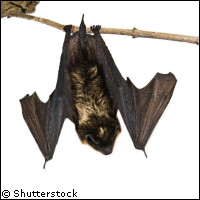Study sheds new light on bats' animal magnetism
Bats use a magnetic substance called magnetite as an 'internal compass' to help them navigate, scientists have found. The research, which was partly funded by a Marie Curie grant from the EU, is published in the journal PLoS ONE. Bats' ability to navigate using the Earth's magnetic field was discovered in 2006, but until now the mechanism it uses has remained a mystery. Do they use a light-dependent system, like many birds? Or do their cells contain special compass compartments filled with magnetite, like some other animals? In this latest study, scientists from the University of Leeds in the UK and Princeton University in the US exposed big brown bats (Eptesicus fuscus) to a magnetic pulse 5,000 times stronger than the Earth's magnetic field but oriented in the opposite direction. If, as suspected, the bats' magnetic ability is based on magnetite, such a pulse would flip the polarity of the magnetite particles, effectively turning north into south. 'We had three groups of bats. One had undergone the magnetic pulse with a different orientation, and one control group had received no pulse at all,' explained Dr Richard Holland of the University of Leeds. 'The third group had undergone the pulse, but in the same orientation as the Earth's magnetic field. By including this group, we could easily see if changes in behaviour were the result of confusion caused by the pulse itself rather the impact of its orientation on the magnetite.' The birds were then released and their progress tracked via radio transmitters attached to the bats. They found that the control group made its way home as normal, as did the bats which had received a pulse oriented in the same direction as the Earth's magnetic field. However, half the bats which had received a pulse oriented in the opposite direction to the Earth's magnetic field set off in the opposite direction. 'This clearly showed that it is the magnetite in their cells which gives bats their direction as we were able to change how the bats used it as an internal compass, turning their north into south,' commented Dr Holland. The bats that flew in the right direction could have switched to additional navigational cues when they realised that there was something wrong with their magnetic sense, the scientists speculate. A wide variety of species have been found to have a magnetic sense, including birds, insects, lobsters, salamanders, turtles, fish, mammals and bacteria. The next challenge for researchers is to work out how the magnetic sense of bats works. 'As yet, the location of the receptor cells containing magnetite in bats is unknown and the structure of the receptor cells in any animal also remains to be determined,' the researchers state. 'It is crucial to our understanding of magnetoreception by magnetite based cells that the ultrastructure of the magnetoreceptors be determined.'
Countries
United Kingdom, United States



